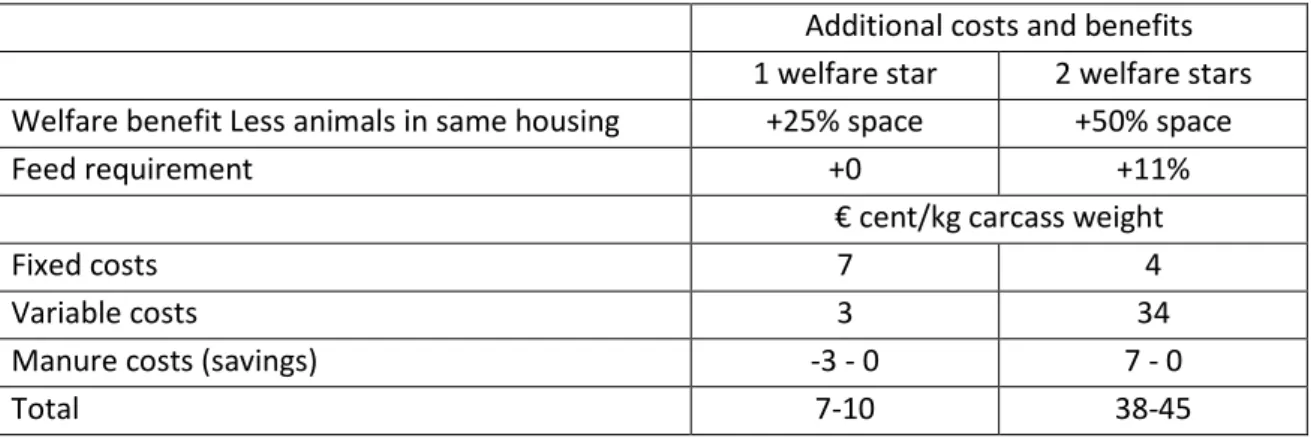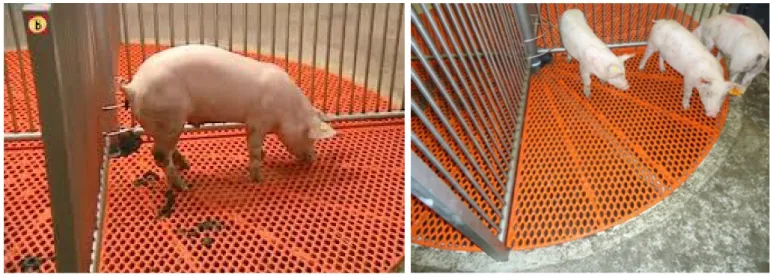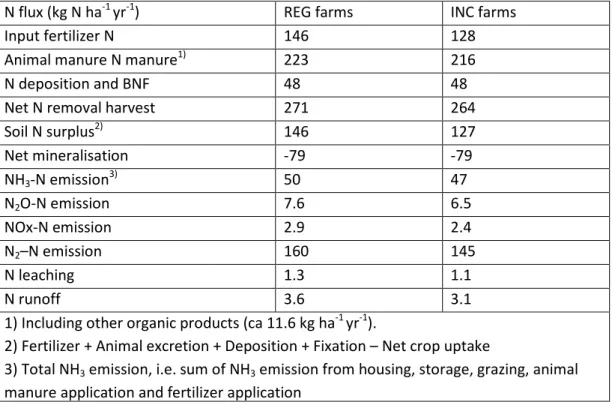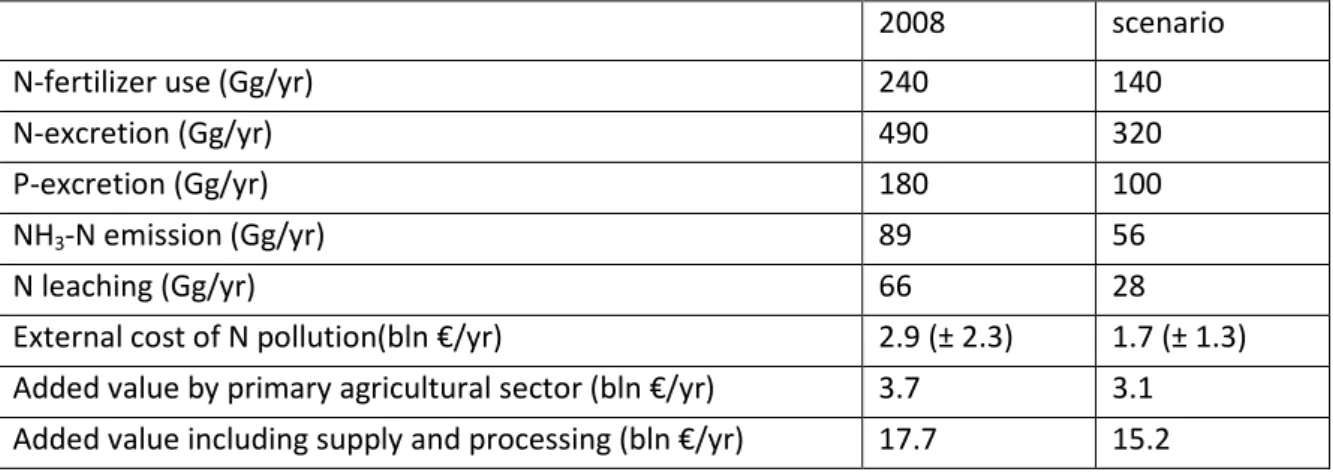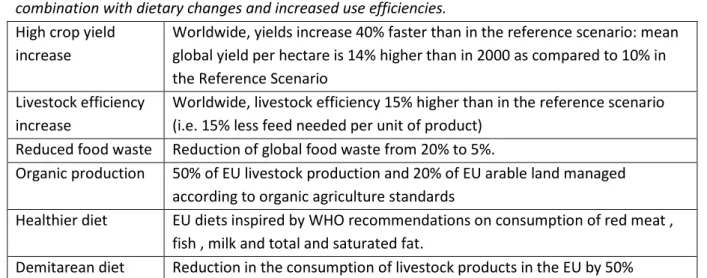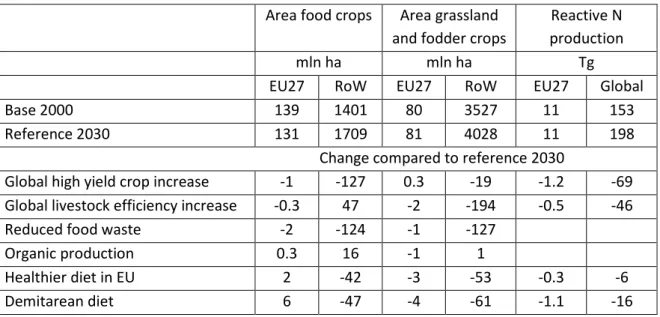1
ERL: special issue: Nitrogen Management Challenges: From Global to Local Scales
Supplementary material
Potential of extensification of European agriculture for a more sustainable
food system; the case for nitrogen and livestock
Hans J.M. van Grinsven1, Jan Willem Erisman2, Wim de Vries3, Henk Westhoek1
2.1 Impacts of low input organic dairy farming in the Netherlands on milk yields and farm income
Provisional data from two farms is encouraging but are only indicative. Both farms represent a larger group of about 50 dairy farmers in the Netherlands (0.3% of total farms) that combine intensive grazing and minimal use of feed concentrates and silage maize. These dairy farmers apply rapid rotation grazing, or strip grazing, which typically involves a wagon-wheel arrangement of fences. In the Dutch examples fences are moved up to six times per day. Dairy cattle is consecutively confined no longer than 30 days per year (in winter).
One farm generates additional income mainly by the premium for organic milk. The other farm creates additional income by on farm production of cheese which is mainly exported via a private distribution channel. The two example farms also save money on purchase of chemical inputs, veterinary services and contract workers. On-farm production and independent distribution of dairy products like cheese, but also kefir, are ways to create additional added value to compensate for production loss per hectare of land. Both farms are organic and have applied strip grazing for over ten years and have solved various start up problems. The first five to ten years in changing to low input, strip grazing is critical, because grass sward, soil processes and cows have to adjust to the new regime and both farms had problems producing enough forage and with animal health.
2.2 Impact of improved animal welfare pig production systems in the Netherlands on farm income
Bens and Schrijver (2012) compared the economic performance of the two alternative pig systems production with improved welfare with a conventional production system. This analysis was assigned by retail to calculate the premium prices for retail to pig farmers using systems with improved
welfare. For the analysis the number of finishing pigs on a conventional farm was 2000, which is close to the Dutch mean pig farm size, for farms transferred to the one star system 1500 pigs and to the two star (free roaming) system 1300 pigs (Table 1).
Table 1. Additional costs and benefits of a one star and two welfare pig production system, as compared to a conventional system (adapted from Bens and Schrijver 2012).
Additional costs and benefits 1 welfare star 2 welfare stars Welfare benefit Less animals in same housing +25% space +50% space
Feed requirement +0 +11%
€ cent/kg carcass weight
Fixed costs 7 4
Variable costs 3 34
Manure costs (savings) -3 - 0 7 - 0
2
Production costs for the one star system increase modestly because feed requirement for pigs raised under such a system is similar to that in a conventional system. Feed requirement increases due to more physical activity. However, this is compensated by more efficient feed conversion due to improved animal health and decreased feeding stress (Bens and Schrijver 2012). As feed requirement is similar to conventional systems there are also no additional costs for manure disposal per pig for individual farms. When there would be a massive change to this system, total production of pig manure would decrease, which could increase the price arable farmers are willing to pay, and even decrease the cost of manure disposal per pig.
Figure 1. Pig toilet for separation of urine and feaces at experimental pig farm in Sterksel, the Netherlands (Photo: Agrarisch Dagblad). Increasing floor space to allow pigs to express their natural behaviour also creates opportunities to improve recycling and fertilizer value of manure.
Feed conversion for the 2 star system is less efficient than in the 1 star and conventional systems in view of slower growth and more physical activity. Additional cost for feed in the fattening phase is 0.12 € per kilogram (20% higher). Cost for breeding increase by 0.09 € (35% higher). The increased feeding costs for the fattening pigs are due to a higher feed requirement (2.9 kg feed per kg of live weight, versus 2.6 in conventional) and the need for more expensive feed which is enriched with linseed. The increased breeding costs are caused by a lower productivity of the sows (23.7 piglets per sow per year as compared to 27.6 in conventional) and increased cost of labour and housing per sow (Bens and Schrijver, 2012).
An additional benefit for systems with more freedom of movement is the possibility to separate pig urine and solid manure by installing pig toilets, that use the natural tendency of pigs to pee and poo in different corners of the housing (Figure 1). This natural separation can additionally reduce manure disposal costs for the pig farmer, and increase the nutrient use efficiency for the arable farmer using the manure. However, when improved welfare is combined with poor manure management there is a risk of increase emissions of ammonia.
3
2.3 Impacts of improved nutrient cycling approaches in the Netherlands on farm income and environment
Dolman et al (2014) evaluated the integrative economic, environmental and societal performance of selected INC farms (with improved internal nutrient cycle) in the Northern Friesian Woodlands in comparison to regular (REG) benchmark farms. Economic indicators included farm income, environmental indicators used were land occupation, non-renewable energy use, global warming potential, acidification potential and eutrophication potential expressed per kg fat-and-protein-corrected milk (FPCM). Use societal indicators included payments for agri-environmental measures and grazing hours of cows.
INC farms reduce protein contents of dairy- cow diets, leading to lower total and mineral N contents in animal slurry, minimum use of synthetic N fertilizers whilst also minimizing grassland renovation (De Boer et al 2012). The latter contrasts with farming practices where grasslands are regularly, about every 5 to 10 years, ploughed and reseeded
In addition, the overall environmental impacts of INC farming at landscape level was evaluated with an integrated modelling system INITIATOR, using spatially explicit input data on animal numbers, land use, agricultural management, meteorology and soil, assuming that all farms practiced the principle of INC farming (De Boer et al 2012). Involved environmental indicators at landscape level included N inputs, N uptake and N and emission to air (ammonia, nitrous oxide) and water (nitrate) and N deposition on nearby Natura 2000 areas. Results are show in (Table 2).
Table 2: Calculated environmental impacts in the region of the Noordelijke Friese Wouden in terms of average N fluxes, assuming the occurrence of only regular(REG) farms or only farms with an improved internal nutrient cycle (INC).
N flux (kg N ha-1 yr-1) REG farms INC farms
Input fertilizer N 146 128
Animal manure N manure1) 223 216
N deposition and BNF 48 48
Net N removal harvest 271 264
Soil N surplus2) 146 127 Net mineralisation -79 -79 NH3-N emission3) 50 47 N2O-N emission 7.6 6.5 NOx-N emission 2.9 2.4 N2–N emission 160 145 N leaching 1.3 1.1 N runoff 3.6 3.1
1) Including other organic products (ca 11.6 kg ha-1 yr-1).
2) Fertilizer + Animal excretion + Deposition + Fixation – Net crop uptake
3) Total NH3 emission, i.e. sum of NH3 emission from housing, storage, grazing, animal
4
3.1 Effects of extensification of the Dutch livestock sector on external cost and economic
welfare
A livestock density in the Netherlands of 3.4 LSU per hectare (one LSU corresponds to the feed requirement of one adult dairy cow) is more than four times higher than the EU average, in part due to a combined presence of large stocks of dairy cattle, pigs and poultry. At the same time feed conversion rates and emissions per unit of product are among the lowest. However, ammonia and nitrate emissions per hectare are still high in spite of a nearly 50% reduction in the past 25 years (Van Grinsven et al 2012) and biodiversity has decreased rapidly especially the population of red list birds. As about half of all the livestock products from the Dutch livestock sector are exported, there is an ongoing debate in Dutch society on whether the current situation is optimal or desirable for the Netherlands, the EU27 and the world at large (Eijsackers and Rabbinge 2013). The central question for Dutch society is if the loss of environmental quality and the increase of human health risks in the Netherland due to livestock production for export is outweighed by an increase of gross domestic product (GDP), farm income and employment. This situation might benefit from a combination of extensification and income compensation in the Netherlands, and intensification in other areas of the EU, where there is room to do so given the environmental limits for among others eutrophication and acidification.
Results for a scenario with 50% reduction of pig and poultry livestock, 20% reduction of dairy
livestock and 40% reduction of the use of synthetic N fertilizer are given in Table 3 and were obtained from Van Grinsven et al. (2012). Effects and related external costs were calculated for nitrate
leaching and ammonia emission and for yields of crops, meat and dairy. Arable land becoming available because of the reduced demand of silage maize and grass was converted to feed cereals for pig and poultry. Direct economic impacts of a change in size and structure of the livestock sector on GDP were linearly extrapolated from the GDP contribution (added value). GDP contribution in 2008 was 9.5 billion euro, including supply and processing, and 1.5 billion euro for primary production. Table 3. Nutrient fluxes, external environmental costs of nitrogen addition and added value of the primary agricultural sector and the total agro-sector in 2008 and a scenario with a 50% reduction of the pig and poultry livestock, a 20% reduction of the dairy livestock and a 40% reduction of the use of synthetic N fertilizer.
2008 scenario
N-fertilizer use (Gg/yr)
240 140 N-excretion (Gg/yr) 490 320 P-excretion (Gg/yr) 180 100 NH3-N emission (Gg/yr) 89 56 N leaching (Gg/yr) 66 28
External cost of N pollution(bln €/yr) 2.9 (± 2.3) 1.7 (± 1.3) Added value by primary agricultural sector (bln €/yr) 3.7 3.1 Added value including supply and processing (bln €/yr) 17.7 15.2
Valuation and monetization of environmental pollution is controversial in view of both conceptual issues and lack of valuation data (Van Grinsven et al 2013). Glendining et al (2008) concluded from a LCA study that the current level of intensification in UK agriculture is sustainable. Their approach
5
included the external cost of pollution by nitrogen (N), phosphorus (P), pesticides and climate change and the cost of land extension. However, the environmental cost of eutrophication per unit of leached N (0.16 euro/kgN) in Glendining et al (2008) was much lower than values used by Van Grinsven et al. (2013; 5-20 euro/kgN for eutrophication and 0-4 euro/kgN for health impacts via drinking water). Unit cost values in Van Grinsven et al (2013) are based on willingness to pay (WTP) to prevent a wide range of effects, while values in Glendining et al (2008) are based on cost of N-removal from drinking water and on value loss of real estate and tourism. Using the high cost values for N by Van Grinsven et al. in the LCA approach by Glendining et al (2008) would have increased the cost of eutrophication by N by a factor of 30-250, and probably would have led to the conclusion that current levels of nutrient intensity in the UK were suboptimal for society. Van Grinsven et al (2013) estimated the external cost of N pollution by agriculture for the EU in 2008 at 120 billion euro per year and for the Netherlands at 6 billion euro (both about 2% of GDP). Uncertainty and lack of data is a major setback when valuing the cost of pollution, as emphasized in both papers. Furthermore, given the high uncertainty in economic valuation of environmental/social impacts of N pollution (ranging between 0.6 and 4% of GDP in 2008 of the EU) it is doubtful whether this is currently the right metric to find optimal solutions for sustainability.
3.2 Global and regional effects of extensification of agricultural production
Results for alternative food production and consumption scenarios for the EU27 were obtained from Westhoek et al (2011). Scenario used are shown in Table 4 and results in Table 5.
Table 4. Scenarios for 2020 used in a European wide study assessing effects of low input farming in combination with dietary changes and increased use efficiencies.
High crop yield increase
Worldwide, yields increase 40% faster than in the reference scenario: mean global yield per hectare is 14% higher than in 2000 as compared to 10% in the Reference Scenario
Livestock efficiency increase
Worldwide, livestock efficiency 15% higher than in the reference scenario (i.e. 15% less feed needed per unit of product)
Reduced food waste Reduction of global food waste from 20% to 5%.
Organic production 50% of EU livestock production and 20% of EU arable land managed according to organic agriculture standards
Healthier diet EU diets inspired by WHO recommendations on consumption of red meat , fish , milk and total and saturated fat.
6
Table 5. Impacts of low input farming in combination with dietary changes and increased use efficiencies on needed areas of food crops, grassland and fodder crops and reactive N production in 2030 (Westhoek et al. 2011 - results of LEITAP-IMAGE model).
Area food crops Area grassland and fodder crops
Reactive N production
mln ha mln ha Tg
EU27 RoW EU27 RoW EU27 Global
Base 2000 139 1401 80 3527 11 153
Reference 2030 131 1709 81 4028 11 198
Change compared to reference 2030
Global high yield crop increase -1 -127 0.3 -19 -1.2 -69 Global livestock efficiency increase -0.3 47 -2 -194 -0.5 -46
Reduced food waste -2 -124 -1 -127
Organic production 0.3 16 -1 1
Healthier diet in EU 2 -42 -3 -53 -0.3 -6
Demitarean diet 6 -47 -4 -61 -1.1 -16
Additional references
Bens P and Schrijver G 2012 Kostenanalyse varkenshouderij met een Beter Leven Kenmerk (in opdracht van PBL), DLV Intensief Advies BV (in Dutch)
Eijsackers H, & Rabbinge R. 2013 Animal husbandry, widened objectives from liability to asset.
NJAS-Wageningen Journal of Life Sciences 66 83-84
Glendining M J, Dailey A G, Williams A G, Van Evert F K, Goulding K W T, and Whitmore A P 2009 Is it possible to increase the sustainability of arable and ruminant agriculture by reducing inputs?
